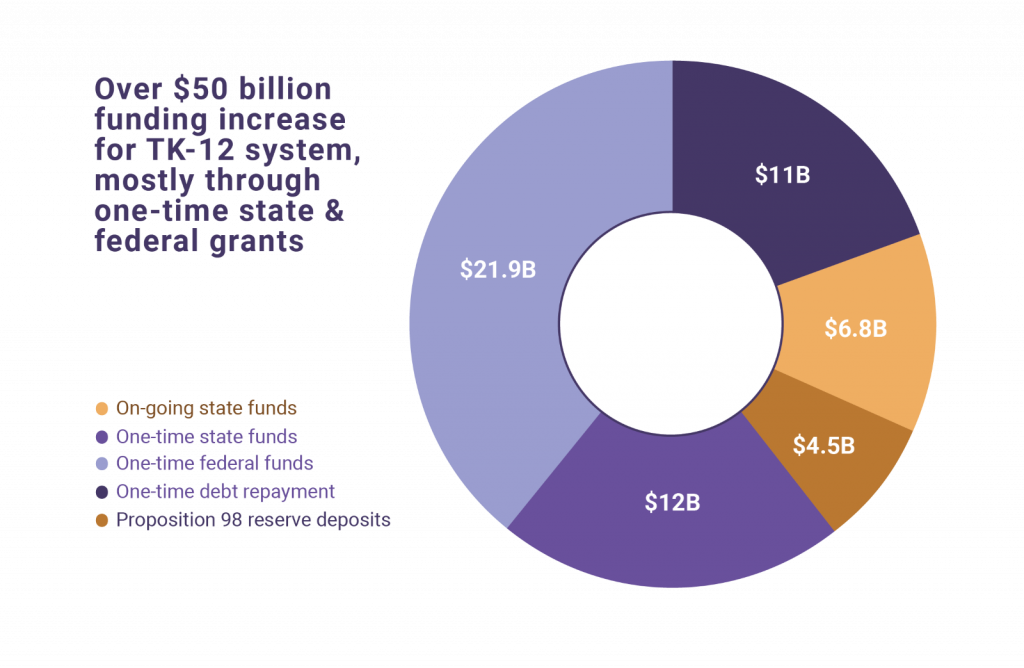By the Children Now Education Team
January 5, 2022
Top image via iStock from artist kali9
Recent economic growth has resulted in a substantial influx of one-time and long-term funds for California public education. Money matters, but a severe education workforce shortage and capacity constraints in California schools may dampen the impact of these new budget resources if state policymakers don’t invest them effectively. With a solid foundation of stable and capable leadership combined with support structures and consistent staffing in positive school environments, additional money can provide meaningful opportunities and services for kids, which leads to better outcomes. Still, tragically, California schools have been woefully underfunded and subsequently on shaky ground since the 1970s. It is critical that state policymakers spend the substantial new, ongoing, and one-time funds earmarked for education in ways that build and retain the talent pool in TK-12 schools and invest in fiscal strategies that ensure students, especially students in low-income households, students who are English Learners, and students in foster care, truly benefit from the rapid rise in revenue the state is experiencing.
Over the last several decades, California has trailed the nation in K-12 education investments. Before this school year, California hovered among the lowest quartile of states in per-pupil funding when adjusted for cost, and has remained below 85% of the national average in per pupil spending over the last two decades. Compounding the funding issue, as of late, state policymakers have established a pattern of underestimating the amount of funding owed to schools. While this approach helps create a cushion in the state budget, it also creates a “settle-up” requirement the following year and is one of the main reasons there tends to be such significant one-time funding owed to schools each budget cycle. While one-time funding is greatly welcomed, especially given the enhanced levels of need that have been present during the pandemic, nearly 88% of increased funding schools received this year is one-time in nature, and school districts have no guarantee that those newly available funds will continue. That uncertainty simply wreaks havoc for school districts, precluding them from committing to hiring staff for the long term – which, in turn, leads to poor program implementation and rapid staff turnover. To better support students, the State should end this practice of underestimating by investing in ongoing ways that promote stability and support effective planning and implementation at the local level.
 California has some of the nation’s highest student-staff ratios, resulting in large class sizes, inadequate student supports, and overworked staff, which in combination negatively impacts school environments for kids. This staff-student ratio problem has been exacerbated by California’s significant and growing educator shortages. Districts are struggling to find and hire the teachers, counselors, social workers, and nurses, among others, who are a critical presence at schools, and work closely with kids. So much so that compared to pre-pandemic times, kids reported a decrease in the availability of an adult at school that they could talk to when feeling stressed or having problems. It is impossible to accurately quantify school staffing shortages due to a lack of data available at the state level, however, reports show minimal changes in the output of our teacher preparation programs, a spike in numbers for those leaving the profession in 2020/2021, and a higher than usual number of vacancies well into the 2021/2022 school year. Changes in requirements for the demonstration of basic skills and subject matter competency in the 2021-2022 budget helped reduce two structural barriers to entering the profession. While it is still too soon to measure or feel the impact of those changes, we cannot afford to wait, and steps must be taken to address this current and chronic school staffing shortage now.
California has some of the nation’s highest student-staff ratios, resulting in large class sizes, inadequate student supports, and overworked staff, which in combination negatively impacts school environments for kids. This staff-student ratio problem has been exacerbated by California’s significant and growing educator shortages. Districts are struggling to find and hire the teachers, counselors, social workers, and nurses, among others, who are a critical presence at schools, and work closely with kids. So much so that compared to pre-pandemic times, kids reported a decrease in the availability of an adult at school that they could talk to when feeling stressed or having problems. It is impossible to accurately quantify school staffing shortages due to a lack of data available at the state level, however, reports show minimal changes in the output of our teacher preparation programs, a spike in numbers for those leaving the profession in 2020/2021, and a higher than usual number of vacancies well into the 2021/2022 school year. Changes in requirements for the demonstration of basic skills and subject matter competency in the 2021-2022 budget helped reduce two structural barriers to entering the profession. While it is still too soon to measure or feel the impact of those changes, we cannot afford to wait, and steps must be taken to address this current and chronic school staffing shortage now.
Fortunately, it appears very likely that substantial additional state revenue will be available to support schools next year. The Legislative Analyst Office estimates there will be upwards of $10 billion for ongoing spending priorities, on top of meeting existing spending requirements, plus an additional $10 billion in one-time funds. These resources would provide an opportunity to invest in strategies that can stabilize schools now and into the future for the benefit of all students. Specifically, California needs to invest in people, ensuring more skilled and knowledgeable adults are working and building relationships with kids.
Estimated additional $20 billion available for education in 2022-23 state budget.
This is on top of existing required additional spending, including scheduled program expansions, such as transitional kindergarten and expanded learning, $4.4 billion for a 5.35% COLA, and a $3.1 billion deposit into the Proposition 98 budget reserve. Specifically, it is estimated there will be $10 billion in additional ongoing funds, including $5 billion from last year’s budget used for one-time purposes and another $5 billion in revenue that could be used for ongoing investments. It appears likely that additional one-time Proposition 98 funds of nearly $10 billion also will be available for education-related spending.
Policymakers should especially be looking to invest in strategies that help build the talent pipeline and retain the existing workforce. These investments should align with the budget priorities of the Equity Coalition, which is comprised of civil rights, advocacy, community, parent, student, educator, and other organizations. The coalition has worked diligently on the passage and implementation of the Local Control Funding Formula (LCFF) and its accountability system. Children Now is a founding member. Those priorities include:
- Building on the state’s investments in teacher recruitment strategies, such as the Teacher Residency Program. It will take several years of ongoing and sustained investments to address California’s shortage of STEM, bilingual, transitional kindergarten (TK), and special education teachers and support efforts to recruit more teachers of color to serve California’s diverse student populations better. Implementing effective teacher recruitment strategies requires building the infrastructure and hiring the staff necessary to achieve these critical goals.
- Expanding the capacity of public university educator preparation programs to increase the number of enrollees and support their expedited completion of certification.
- Supporting distinct bilingual teacher investments that include:
- Funding to expand the California State University system’s bilingual authorization programs, hire additional faculty, and build student enrollment.
- Investing in another cohort of teachers and paraprofessionals for the Bilingual Teacher Professional Development Program. This investment would allow the recruitment of credentialed teachers who are bilingual and interested in obtaining their bilingual authorization, thus improving the quality of bilingual instruction for bilingual students.
- Securing a second round of funding for the Educator Workforce Investment Grant. This grant funds the implementation of the English Learner (EL) Roadmap and professional learning opportunities for teachers and paraprofessionals across California.
- Focusing on retention at LCFF high-concentration schools by augmenting teacher supports and compensation through adding and funding several educator buyout days that allow for additional professional development and collaboration time for teachers during the summer and intersession. Buyout days may be an especially pragmatic solution given the overall workforce shortage, particularly the challenge of hiring substitutes to allow in-school-year professional development.
Furthermore, state policymakers should prioritize additional equity-oriented fiscal strategies that ensure opportunities and services for low-income students, students of color, students in foster care, students receiving special education services, and students who are English Learners. Those strategies should include:
- Evaluate the implementation of the state’s 8-year-old funding formula (LCFF) and consider different approaches as necessary to strengthen the formula to ensure California delivers on its promise of educational equity. Alternate methods might include:
- Increasing the Supplemental and Concentration grant funding rates provided to districts with a higher concentration of low-income students, English Learners, and kids in foster care (currently 20% of Base grant funding provided for Supplemental and 50% of Base grant funding for Concentrations above 55% of the district enrollment),
- Tweaking the funding structure to provide even more funds for students who meet more than one criterion for additional funding (currently, they are counted only once no matter how many criteria they meet), and/or
- Modifying the funding formula to lower the student population concentration threshold of low-income, English Learners, or youth in foster care (currently 55%) at which districts begin receiving additional funds.
- Addressing the projected enrollment decline of 540,000 students statewide (approximately 9% of students) over the next decade by taking a long-term systematic approach to this issue, including strategies to stabilize staffing year over year and improve the level of service (smaller classes and more support teachers and other support staff per pupil), particularly at high-concentration schools.
- Building on existing efforts before launching any new large-scale initiatives; including ongoing programmatic funding and facilities resources, where appropriate, to support effective implementation of crucial programs such as expanded learning, community schools, California’s Community Engagement Initiative, supplemental funding for reducing staff ratios at high-concentration schools, school-county mental health partnerships, and TK.
Policymakers should use the significant influx of state revenue owed to schools to begin to right the wrongs of the past. Students deserve stability in their school community, access to more caring and skilled adults, and the guarantee that services and programs will be effectively and equitably implemented and available to them now and into the future.
[i] Education Week (2019). Quality counts 2019: School finance. Retrieved from https://www.edweek.org/ew/collections/qualitycounts-2019-state-finance/index.html
[i] National Center for Education Statistics (2016). Chapter 2. Elementary and secondary education. Retrieved November 2019 from https://nces.ed.gov/programs/digest/d18/tables/dt18_213.50.asp?current=yes


